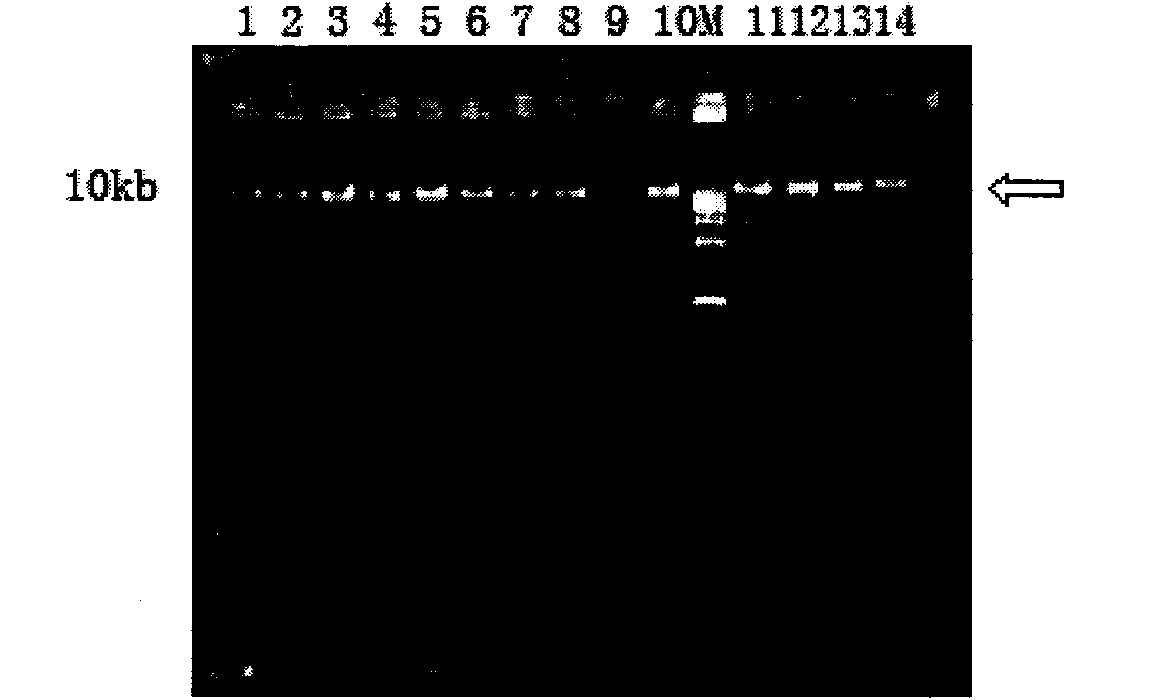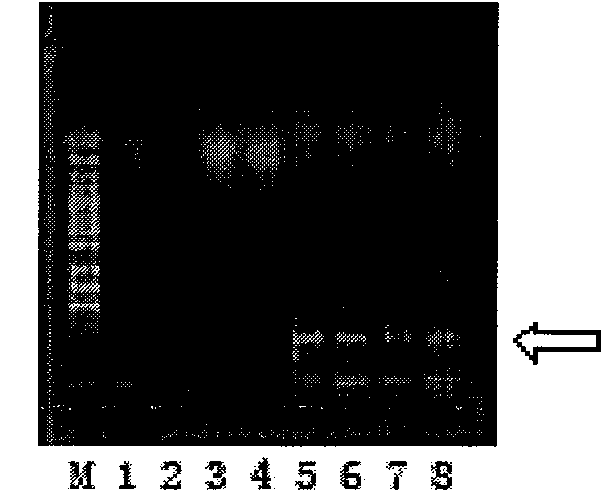Extraction method of mangrove plant DNA
An extraction method, the technology of mangrove plants, which is applied in the field of plant DNA extraction, can solve the problems of high-demand operations that cannot be carried out smoothly, high operating technical requirements, and genomic DNA loss, so as to prevent precipitation, high purity, and remove polysaccharides. Effect
- Summary
- Abstract
- Description
- Claims
- Application Information
AI Technical Summary
Problems solved by technology
Method used
Image
Examples
Embodiment 1
[0030] (1), put 0.1g of leaves into a mortar, add a small amount of quartz sand, fully grind into powder with liquid nitrogen, add 0.5ml of preheated 2% CTAB extract to dissolve, 2% CTAB extract includes 2% CTAB, 0.1 TrisHCl of mol / L, EDTA of 20mmol / L, NaCl of 1.4mol / L and 1% β-mercaptoethanol, the pH value of described TrisHCl is 8.0, then add 50 μ l 2% PVP, pack into 1.5ml centrifuge tube, total The volume is about 0.5ml;
[0031] (2) Put it in a water bath at 55°C for 60 minutes, add 2 μl RNase, keep warm at 37°C for 1 hour, then add about 0.5ml of chloroform-isoamyl alcohol mixture and mix, chloroform and isoamyl alcohol in the chloroform-isoamyl alcohol mixture The ratio of isoamyl alcohol is 24:1, and it is centrifuged at 8000 rpm for 15 minutes at room temperature;
[0032](3), take the supernatant and transfer it to a centrifuge tube, add 1 / 2 volume of preheated 2% CTAB extract, the 2% CTAB extract is consistent with the previous step (1), then add an equal volume of ...
Embodiment 2
[0036] (1), take 0.1g of fresh tender leaves and put them into a mortar, add a small amount of quartz sand, fully grind them into powder with liquid nitrogen, add 0.5ml of preheated 2% CTAB extract to dissolve, 2% CTAB extract includes 2% CTAB , the TrisHCl of 0.1mol / L, the EDTA of 20mmol / L, the NaCl of 1.4mol / L and the β-mercaptoethanol of 1%, the pH value of described TrisHCl is 8.0, add 50 μ l 2% PVP again, pack into 1.5ml centrifuge tube , the total volume is about 0.5ml;
[0037] (2) Place in a water bath at 55°C for 45 minutes, add 2 μl of RNase, incubate at 37°C for 1.5 hours, then add about 0.5ml of chloroform-isoamyl alcohol mixture and mix, chloroform and isoamyl alcohol in the chloroform-isoamyl alcohol mixture The ratio of isoamyl alcohol is 24:1, and it is centrifuged at 12000 rpm for 10 minutes at room temperature;
[0038] (3), take the supernatant and transfer it to a centrifuge tube, add 1 / 2 volume of preheated 2% CTAB extract, the 2% CTAB extract is consiste...
Embodiment 3
[0042] (1), put 0.2g fresh leaves into a mortar, add a small amount of quartz sand, fully grind into powder with liquid nitrogen, add 1ml of preheated 2% CTAB extract to dissolve, 2% CTAB extract includes 2% CTAB, 0.1 TrisHCl of mol / L, the EDTA of 20mmol / L, the NaCl of 1.4mol / L and the β-mercaptoethanol of 1%, the pH value of described TrisHCl is 8.0, then add 100 μ l 2% PVP, pack into 5ml centrifuge tube, total volume About 1ml;
[0043] (2) Put it in a water bath for 80 minutes at 60°C, add 6 μl RNase, keep warm at 37°C for 2 hours, then add about 1 ml of chloroform-isoamyl alcohol mixture and mix, chloroform and isoamyl alcohol in the chloroform-isoamyl alcohol mixture The proportioning ratio of amyl alcohol is 24:1, and it is centrifuged at 10,000 rpm for 10 minutes at room temperature;
[0044] (3), take the supernatant and transfer it to a centrifuge tube, add 1 / 2 volume of preheated 2% CTAB extract, the 2% CTAB extract is consistent with the previous step (1), then add...
PUM
 Login to View More
Login to View More Abstract
Description
Claims
Application Information
 Login to View More
Login to View More - R&D
- Intellectual Property
- Life Sciences
- Materials
- Tech Scout
- Unparalleled Data Quality
- Higher Quality Content
- 60% Fewer Hallucinations
Browse by: Latest US Patents, China's latest patents, Technical Efficacy Thesaurus, Application Domain, Technology Topic, Popular Technical Reports.
© 2025 PatSnap. All rights reserved.Legal|Privacy policy|Modern Slavery Act Transparency Statement|Sitemap|About US| Contact US: help@patsnap.com


